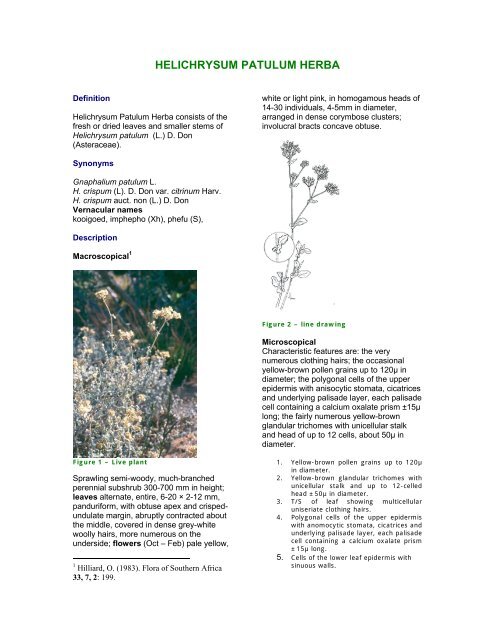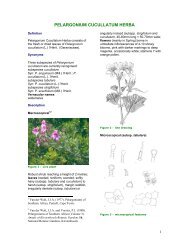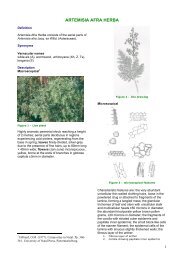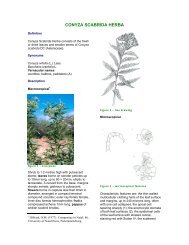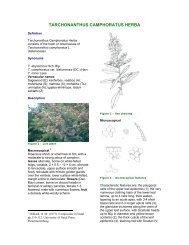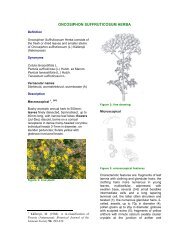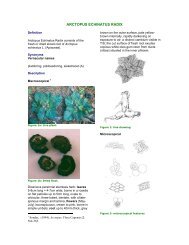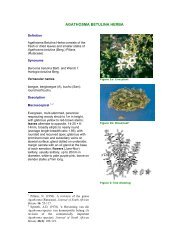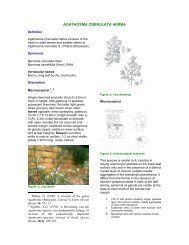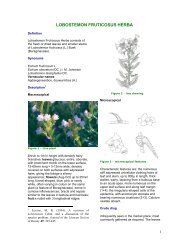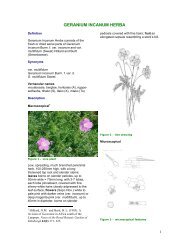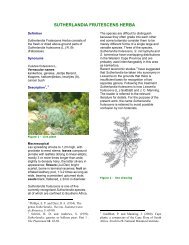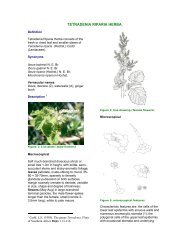HELICHRYSUM PATULUM HERBA - PlantZAfrica
HELICHRYSUM PATULUM HERBA - PlantZAfrica
HELICHRYSUM PATULUM HERBA - PlantZAfrica
Create successful ePaper yourself
Turn your PDF publications into a flip-book with our unique Google optimized e-Paper software.
Definition<br />
Helichrysum Patulum Herba consists of the<br />
fresh or dried leaves and smaller stems of<br />
Helichrysum patulum (L.) D. Don<br />
(Asteraceae).<br />
Synonyms<br />
Gnaphalium patulum L.<br />
H. crispum (L). D. Don var. citrinum Harv.<br />
H. crispum auct. non (L.) D. Don<br />
Vernacular names<br />
kooigoed, imphepho (Xh), phefu (S),<br />
Description<br />
Macroscopical 1<br />
Figure 1 – Live plant<br />
Sprawling semi-woody, much-branched<br />
perennial subshrub 300-700 mm in height;<br />
leaves alternate, entire, 6-20 × 2-12 mm,<br />
panduriform, with obtuse apex and crispedundulate<br />
margin, abruptly contracted about<br />
the middle, covered in dense grey-white<br />
woolly hairs, more numerous on the<br />
underside; flowers (Oct – Feb) pale yellow,<br />
1 Hilliard, O. (1983). Flora of Southern Africa<br />
33, 7, 2: 199.<br />
<strong>HELICHRYSUM</strong> <strong>PATULUM</strong> <strong>HERBA</strong><br />
white or light pink, in homogamous heads of<br />
14-30 individuals, 4-5mm in diameter,<br />
arranged in dense corymbose clusters;<br />
involucral bracts concave obtuse.<br />
Figure 2 – line drawing<br />
Microscopical<br />
Characteristic features are: the very<br />
numerous clothing hairs; the occasional<br />
yellow-brown pollen grains up to 120µ in<br />
diameter; the polygonal cells of the upper<br />
epidermis with anisocytic stomata, cicatrices<br />
and underlying palisade layer, each palisade<br />
cell containing a calcium oxalate prism ±15µ<br />
long; the fairly numerous yellow-brown<br />
glandular trichomes with unicellular stalk<br />
and head of up to 12 cells, about 50µ in<br />
diameter.<br />
1. Yellow-brown pollen grains up to 120µ<br />
in diameter.<br />
2. Yellow-brown glandular trichomes with<br />
unicellular stalk and up to 12-celled<br />
head ±50µ in diameter.<br />
3. T/S of leaf showing multicellular<br />
uniseriate clothing hairs.<br />
4. Polygonal cells of the upper epidermis<br />
with anomocytic stomata, cicatrices and<br />
underlying palisade layer, each palisade<br />
cell containing a calcium oxalate prism<br />
±15µ long.<br />
5. Cells of the lower leaf epidermis with<br />
sinuous walls.
Figure 3 – microscopical features<br />
Crude drug<br />
Collected as required or available in the<br />
marketplace as bundles of fresh or semi-dry<br />
leafy stems, sometimes with flowers/fruits.<br />
The foliage is soft grey-felted and pleasantly<br />
aromatic.<br />
Geographical distribution<br />
Figure 4 – distribution map<br />
Coastal dune bush and south-facing lower<br />
mountain slopes of the Western Cape<br />
Province, from the Cape Peninsula and<br />
Paarl to Bredasdorp and Mossel Bay.<br />
Quality standards<br />
Identity tests<br />
Thin layer chromatography on silica gel<br />
using as solvent a mixture of toluene:diethyl<br />
ether:1.75M acetic acid (1:1:1). Reference<br />
compound cineole (0,1% in chloroform).<br />
Method according to Appendix 2a.<br />
Rf values of major compounds: 0.31<br />
(yellow); 0.47 (yellow); 0.62 (grey); cineole<br />
0.83 (blue-purple)<br />
Figure 5 – TLC Plate<br />
HPLC on C18 column, method according to<br />
Appendix 2b.<br />
Figure 6 a – MeOH HPLC spectrum<br />
Major compounds:<br />
Methanol extract: (figure 6a)<br />
Retention times (mins): 3.63; 11.18; 19.42;<br />
27.15; 28.29
Figure 6 b – DCM HPLC spectrum<br />
DCM extract: (figure 6b)<br />
Retention times (mins): 1.94 ; 5,24<br />
Ethanol (70%) soluble extractive value:<br />
not less than 28.5% (range: 28.88-36.35%)<br />
Purity tests<br />
Assay<br />
Not yet available<br />
Major chemical constituents<br />
Figure 7 – chemical constituents<br />
Of the ±260 Helichrysum species known to<br />
occur in South Africa, some 30 have been<br />
the subject of detailed chemical studies 2 . In<br />
addition to more widespread groups of<br />
secondary metabolites such as flavonoids<br />
(see figure 7) and diterpenes,<br />
acylphloroglucinol and α-pyrone derivatives<br />
appear to be common in the genus and<br />
2 Jakupovic, J., Kuhnke, J., Schuster, A.,<br />
Metwally, M.A. and Bohlmann, F. (1986).<br />
Phloroglucinol derivatives and other constituents<br />
from South African Helichrysum species.<br />
Phytochemistry 25(5): 1133-1142. See also refs.<br />
cited therein.<br />
some unusual acetylenic compounds have<br />
been isolated. Sesquiterpenes such as<br />
labdane derivatives (see figure 7) are also<br />
found. The secondary chemistry of H.<br />
patulum has not been investigated.<br />
Microchemical tests in our laboratories<br />
indicated the presence in this species of<br />
tannins but not of alkaloids, saponins, nor of<br />
cardiac, cyanogenic or anthraquinone<br />
glycosides.<br />
Dosage forms<br />
An aqueous infusion is taken orally.<br />
Medicinal uses<br />
The results of several recent surveys<br />
indicate that H. patulum (often incorrectly<br />
named H. crispum) is used to treat a variety<br />
of ailments including asthma, bladder<br />
infections, gynaecological disorders,<br />
backache, angina pectoris and other cardiac<br />
problems, fatigue, stress, hypertension and<br />
influenza. 3 4 5 6 7 See also GR 1 and 20.<br />
Pharmacology/bioactivity<br />
In vitro antimicrobial activity against<br />
Staphylococcus aureus was demonstrated<br />
by aqueous extracts prepared from dried<br />
leaf material, at a concentration of 10mg/ml.<br />
No activity against Pseudomonas<br />
aeruginosa, Candida albicans or<br />
Mycobacterium smegmatis was shown by<br />
3 Dison, A. (1990). An introductory sociobotanical<br />
survey of the medicinal plants of the<br />
greater metropolitan centre of Cape Town.<br />
Unpublished Honours thesis, Department of<br />
Botany, University of Cape Town.<br />
4 Moerat, A. (1993). A survey of the medicinal<br />
plants used by Rastafarians and Traditional<br />
Practitioners in the south Western Cape<br />
Province. Unpublished Masters thesis,<br />
Department of Botany, University of the Western<br />
Cape.<br />
5 Green, C. M. (1991). A survey of the medicinal<br />
plants in the Stellenbosch region. Unpublished<br />
Honours thesis, Department of Botany,<br />
University of Stellenbosch.<br />
6 Lieberman, D. (1990). Traditional plant<br />
utilisation in the Western Cape. Unpublished<br />
undergraduate study, Department of Botany,<br />
University of Cape Town.
any of the extracts used in preliminary<br />
assays. No other information is available<br />
regarding the bioactivity of this species.<br />
Contraindications<br />
None known.<br />
Adverse reactions<br />
None known.<br />
Precautions<br />
Aside from general caution regarding the<br />
medicinal use of species in Asteraceae by<br />
allergic individuals, there does not at present<br />
seem to be any need for concern in respect<br />
of safety.<br />
Dosage<br />
To be determined.<br />
Copyright in this monograph resides with the authors, the South<br />
African National Biodiversity Institute, the South African Medical<br />
Research Council and the University of the Western Cape. It may<br />
not be reproduced in whole or in part without the written consent of<br />
the copyright holders.


